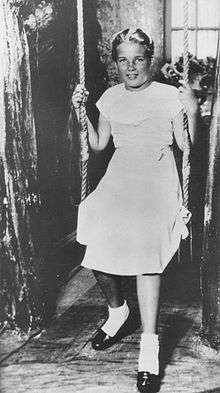Florence Sally Horner
| Florence Sally Horner | |
|---|---|
 Undated photograph of Florence Sally Horner |
Florence Sally Horner (1937 – August 18, 1952) was a girl abducted by a child molester in 1948.
Abduction
In 1948, the 11-year-old Horner stole a 5-cent notebook from a store in Camden, New Jersey. Frank La Salle, a 50-year-old mechanic, caught her stealing, told her that he was an FBI agent, and threatened to have her sent to "a place for girls like you." He then abducted the girl and spent 21 months traveling with her in different U.S. states. According to charges later brought against La Salle, it was during this period that he raped her repeatedly. While attending school in Dallas, Texas, Horner confided her secret to a friend. Later she escaped from La Salle, and phoned her sister at home, asking her to send the FBI. When arrested on March 22, 1950, in San Jose, California, La Salle claimed that he was Florence's father. However, authorities in New Jersey confirmed that Horner's father had died seven years previously. La Salle was tried, convicted, and sentenced to 30 to 35 years in prison under the Mann Act.
Death
Horner died in a car accident near Woodbine, New Jersey, on August 18, 1952.[1] As the Associated Press reported on August 20, 1952: "Florence Sally Horner, a 15-year-old Camden, N.J., girl who spent 21 months as the captive of a middle-aged morals offender a few years ago, was killed in a highway accident when the car in which she was riding plowed into the rear of a parked truck."[2]
Cultural references
Critic Alexander Dolinin proposed in 2005 that Frank La Salle and Florence Sally Horner were the real life prototypes of Humbert Humbert and Dolores "Lolita" Haze from Lolita by Vladimir Nabokov.[3] Although Nabokov had already used the same basic idea—that of a child molester and his victim booking into a hotel as father and daughter—in his then unpublished 1939 work Volshebnik (Волшебник)[4], it is still possible that he drew on the details of the Horner case in writing Lolita. An English translation of Volshebnik was published in 1985 as The Enchanter.[5] Nabokov explicitly mentions the Horner case in Chapter 33, Part II of Lolita: "Had I done to Dolly, perhaps, what Frank Lasalle, a fifty-year-old mechanic, had done to eleven-year-old Sally Horner in 1948?"
Further reading
- Waldman, Katy (2018-09-17). "The Salacious Non-Mystery of "The Real Lolita"". The New Yorker.
- McAlpin, Heller (2018-09-11). "'The Real Lolita' Investigates The True Crime Story Of Sally Horner". NPR.
- Weinman, Sarah (2018-09-11). The Real Lolita. Harper Collins. ISBN 9780062661920.
- Greenwood, T. (2018-08-07). Rust and Stardust. St. Martins Press. ISBN 9781250164193.
References
- ↑ Weinman, Sarah (September 6, 2018). "The Last Days of the Real Lolita: What happened after Sally Horner, whose story helped inspire the novel, returned home". The Cut.
- ↑ Dolinin, Alexander. "What Happened to Sally Horner?". libraries.psu.ed.
- ↑ Dowell, Ben (September 11, 2005). "1940s Sex Kidnap Inspired Lolita". The Sunday Times. Archived from the original on 2005-09-11. Retrieved November 14, 2007.
- ↑ Nabokov, Vladimir. Volshebnik. ISBN 5389056639.
- ↑ Nabokov, Vladimir. The Enchanter. ISBN 0679728864.